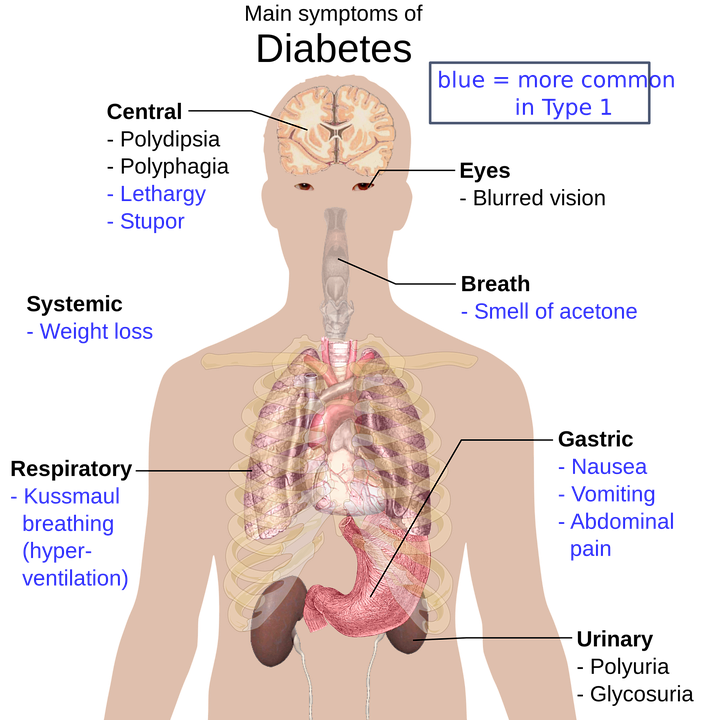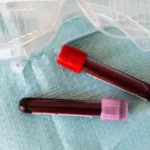The Symptoms of Hyperglycemia are subtle and may not be noticed. Since diabetes is a silent disease and very common, it is important to check your blood glucose at regular intervals especially if you have risk factors of diabetes such as obesity, a family history of diabetes, and advanced age.
Before we dive into the symptoms of hyperglycemia, it is important to know what is meant by it.
What is Hyperglycemia?
Hyperglycemia, more commonly known as high blood sugar, is a condition associated with increased serum glucose levels. It typically occurs in people with diabetes as their blood sugar level spikes.
Many factors can cause hyperglycemia. These factors may include food choices, the status of physical activity, non-diabetes medicines, eating more while staying inactive, stress, or another disease.
Importantly it can occur due to inefficient insulin activity. Since glucose is a fuel of our body and our body needs insulin to metabolize glucose, hyperglycemia in this case can be life-threatening if it goes untreated. In case of negligence towards its treatment, ketoacidosis can occur.
Ketoacidosis or Diabetic Ketoacidosis occurs when inadequate insulin leads to inadequate glucose (fuel). Consequently, your body uses fat stores for energy production.
In order to prevent hyperglycemia, it is crucial to know its possible symptoms. These signs and symptoms can help you detect hyperglycemia at an early stage so that it can be treated efficiently.
| You may also like to read: |
Most Common Signs and Symptoms of Hyperglycemia:
Blood sugars can be checked at home or in a laboratory. If you have a glucometer at home, you can check your blood sugars. It just takes a minute to check your sugar at home via a glucometer.
Since the symptoms of hyperglycemia are very vague, if you have a strong family history of diabetes, you should check your blood sugars routinely.
If you have any of two of the following risk factors, you should check your blood sugars right now:
- Family history of diabetes
- Age above forty years, and
- If your waist circumference is greater than 40 cm.
Upon checking your blood glucose levels through biochemical tests, if your blood glucose level is above the normal range then this is a clear indicator of hyperglycemia.
| You may also like to read: |
Excessive thirst may be a symptom of hyperglycemia:
Excessive thirst or unusual thirst is one of the common symptoms of hyperglycemia. As glucose levels increase in your blood, your kidneys can not reabsorb the extra amount of blood sugars that have been filtered.
Normal kidneys can reabsorb all of the filtered glucose when the glucose level in the blood is less than 180 mg/dl.
There is a condition called familial glucosuria. As the name suggests, this condition runs in families. Affected individuals excrete blood sugars despite normal blood sugars.
This condition is the basis of the novel medicines nowadays used to treat diabetes, the SGLT2 inhibitors (empagliflozin, dapagliflozin, canagliflozin, and ertugliflozin).
When more glucose is excreted in the urine, a lot of water accompanies the urinary sugars resulting in dehydration. As the blood volume is reduced, the osmoreceptors and the baroreceptors sense it and stimulate the thirst mechanism.
Since glucose is excreted in your urine it drags other fluids with it, this causes dehydration. So, thirst is an indirect symptom of hyperglycemia.
Excessive thirst can also occur in other conditions such as diabetes insipidus and excessive sweating as in athletes and laborers.
| You may also like to read: |
Dry Mouth:
People with type 1 or type 2 diabetes may experience dry mouth. This condition can be related to increased thirst as well.
The exact cause of this condition is not yet known but it is suggested that dehydration or the medications used in diabetes may cause it.
A dry mouth is another indirect symptom of hyperglycemia. Like excessive thirst, the degree of dry mouth correlates with the degree of hyperglycemia. As the blood sugars rise, thirst and dry mouth worsen.
High Levels of Glucose in Urine
As increased urine production is caused by increased blood glucose levels and kidneys working to excrete this excessive glucose in urine. This will eventually lead to elevated levels of glucose in urine.
Healthcare physicians always check for sugar levels in urine and blood for possible hyperglycemia. You can check urinary sugars by simple dipstick testing at home.
It is important to note that urinary sugars may not always be indicative of diabetes mellitus. Glucose in urine may be seen in conditions like:
- Urinary tract infection
- Use of SGLT2 Inhibitors (these diabetes drugs act by blocking the reabsorption of filtered glucose back into the blood)
- Urinary stones
- Kidney diseases
- Tumors of the urogenital tract
| You may also like to read: |
Passing a lot of urine is one of the symptoms of hyperglycemia:
As in the case of increased thirst, increased urination is caused by the same mechanism. Since kidneys work overtime to excrete the excessive glucose in your blood, this automatically leads to increased urine production.
People with diabetes produce more urine than healthy individuals on a daily basis.
However, excessive urination can also occur in patients with other conditions such as:
- Urinary tract infection
- Diabetes Insipidus
- Urinary urgency as in overactive bladder
- Prostatic hypertropphy (BPH) or prostatic cancer
- Hypercalcemia (high blood calcium levels)
- Certain medications such as diuretics (Furosemide, hydrochlorothiazide, and spironolactone)
| You may also like to read: |
Fatigue or Tiredness is one of the common symptoms of hyperglycemia:
Another common complaint of people suffering from hyperglycemia is the feeling of tiredness. Such individuals experience fatigue despite having enough sleep and taking proper rest.
This type of fatigue is also called diabetic fatigue. Research has shown the relationship between chronic fatigue and enhanced blood glucose levels. [Ref]
This feeling is caused by your body working continuously to excrete or metabolize supplementary glucose by producing enough insulin. In case of insulin activity or production being defective, fat stores are broken for energy production.
When this occurs, ATP is broken releasing phosphate and converting it into ADP. When such sources of energy are depleted, your body experiences fatigue.
In simple words, “Your Body Is Starving Despite High Blood Sugars”
| You may also like to read: |
Weakness in Hyperglycemia:
Hyperglycemia can cause weakness. Fatigue due to insufficient or inefficient insulin can cause weakness in the long run.
Research has found that diabetics are more prone to loss of muscle mass and this can be a consequence of hyperglycemia [Ref]. This loss of muscle mass can cause weakness in the body and possibly limit mobility.
Blurred Vision: Check your blood glucose!
Your eyesight may be affected due to elevated blood glucose levels. Hyperglycemia can cause blurred vision.
Your eyesight can be compromised as hyperglycemia can cause swelling in the lens of your eyes. This complication can be very disturbing as it can lead to loss of vision if left untreated.
| You may also like to read: |
Abdominal Pain occurs commonly in T1DM with DKA:
This condition is a typical complaint of hyperglycemic patients and occurs in diabetic ketoacidosis. Research has proven the incidence of abdominal pain and discomfort in people with diabetic ketoacidosis.
Abdominal pain is thought to be related to the degree of acidemia (acid in the blood). In patients with T1DM, the absolute deficiency of insulin results in the metabolism of fatty acids. When fatty acids are broken down as a source of energy, ketones are formed. Ketones are of three types:
- Beta-hydroxybutyrate
- Acetoacetate
- Acetone
Acetone is volatile and excreted via exhalation. It produces a characteristic fruity odor. The other two are acids and reduce blood PH.
When the blood pH is lowered (becomes acidic), patients start abdominal pain. This is similar to lactic acidosis when you start to exercise after a long time.

| You may also like to read: |
Recurrent Infections or non-healing Ulcers:
A consistently elevated blood sugar level can weaken your immune system. With your immune system being inefficient, it is hard to control the invasion of foreign bodies and pathogens.
Victims of prolonged hyperglycemia can have peripheral nerve damage leading to decreased blood flow to their extremities. As a result, these subjects become more susceptible to infections.
For this reason, diabetics need to be more conscious of their health as mild infections may develop into lethal abnormalities.
Occasionally, patients with a wound may note that their blood, wound, or serum attracts ants and maggots.
| You may also like to read: |
Slow Healing Wounds:
People with diabetes may also suffer from slow healing of wounds owing to the inefficiency of blood circulation caused by hyperglycemia.
In case of an external injury, proper blood circulation is required to heal wounds. Platelets in the blood help with clotting blood that is oozing out of the wound. Therefore, ineffective blood circulation leads to prolonged healing of wounds.
Apart from impaired blood circulation, there is poor nutrition, low immunity, and the right kind of environment for bacterial overgrowth. All these factors cause a delay in wound healing.
| You may also like to read: |
Unintended Weight Loss is an overlooked symptom of hyperglycemia:
Diabetics have a frequent issue of unintended weight loss. As a consequence of inefficient or insufficient insulin leading to the unavailability of glucose as a fuel in the body, your body breaks down fat reserves for the production of energy for the proper functioning of your organs.
Since the fat and muscle mass are being consumed for these energy needs, visible weight loss occurs.
There is a term called “Diabetic Cachexia” or “Diabetic Neuropathic Cachexia“. Patients with this condition are markedly emaciated and have other complications of diabetes as well such as peripheral neuropathy.
Some patients may also develop exocrine pancreatic insufficiency as occurs in secondary diabetes following pancreatitis and malnutrition-related diabetes (MRDM).
| You may also like to read: |
Polyphagia or overeating:
Polyphagia is a term used to describe enhanced appetite. Hyperglycemia can increase your hunger. The mechanism behind diabetic polyphagia can be the lack of insulin giving rise to the defective utilization of glucose in your body.
Since glucose is not being metabolized in the body, it starts craving more food to compensate for this. Therefore, subjects of hyperglycemia feel excessive hunger.
| You may also like to read: |
Do you have any of the above symptoms of Hyperglycemia?
If Yes, Check your blood glucose. You have diabetes mellitus if two or more of your blood glucose falls above these normal ranges.
Normal Ranges of Blood Sugar Level
- Fasting or Premeal blood sugars of less than 100 mg/dl or 5.5 mmol/L
- Two hours post meals blood sugars less than 140 mg/dl or 7.78 mmol/L
Blood Sugar readings that fall in the range of Diabetes:
- Fasting or Premeal blood sugars exceeding or equal to 126 mg/dl or 7 mmol/L
- Two hours post meals blood sugars exceeding or equal to 200 mg/dl or 11.11 mmol/L
Blood Sugar readings that fall in the range of Pre-Diabetes:
- Fasting or Premeal blood sugars between 100 and 126 mg/dl (5.5 and 7 mmol/L)
- Two hours post meals blood sugars between 140 and 200 mg/dl (7.78 and 11.11 mmol/L)
| You may also like to read: |




